When you’re starting a business, one of the first decisions you’ll need to make is what type of business structure to choose. Two of the most common options are a sole proprietorship and a limited liability company (LLC).
what is a sole proprietorship
A sole proprietorship is the simplest and most common type of business structure. It’s easy to set up and doesn’t require any paperwork. However, it doesn’t offer any personal liability protection, which means that your personal assets are at risk if your business is sued or goes bankrupt.
what is an llc
An LLC is a more formal type of business structure that offers limited liability protection. This means that your personal assets are generally safe from creditors if your business is sued or goes bankrupt. LLCs are also relatively easy to set up, but they do require more paperwork and maintenance than sole proprietorships.
Which business structure is right for you?
The best business structure for you will depend on your individual circumstances and the type of business you’re starting. Here’s a comparison of sole proprietorships and LLCs to help you decide:
| ** | Feature | Sole proprietorship | LLC |
|---|---|---|---|
| Ease of setup | Very easy | Easy | |
| Cost | Free or low cost | Filing fees and annual fees vary by state | |
| Liability protection | None | Limited liability | |
| Taxation | Pass-through entity | Pass-through entity | |
| Ownership | Can only have one owner | Can have one or multiple owners | |
| Management | Managed by the owner | Managed by the owner(s) or manager(s) |
Sole proprietorships
Sole proprietorships are the simplest and most common type of business structure. They’re easy to set up and don’t require any paperwork. To start a sole proprietorship, you simply need to start doing business under your own name.
Advantages of sole proprietorships:
- Easy to set up and maintain
- No filing fees or annual fees
- Full control over the business
Disadvantages of sole proprietorships:
- No personal liability protection
- Difficult to raise capital
- May not be able to get certain business licenses or permits
LLCs
LLCs are a more formal type of business structure that offers limited liability protection. This means that your personal assets are generally safe from creditors if your business is sued or goes bankrupt. LLCs are also relatively easy to set up, but they do require more paperwork and maintenance than sole proprietorships.
Advantages of LLCs:
- Limited liability protection
- Easy to set up and maintain
- Can have multiple owners
- More flexible management structure
Disadvantages of LLCs:
- Filing fees and annual fees vary by state
- More complex tax structure
- May not be able to get certain business licenses or permits
Which business structure is right for you?
The best business structure for you will depend on your individual circumstances and the type of business you’re starting. Here are some general guidelines:
- If you’re just starting out and have a low-risk business, a sole proprietorship may be the best option for you. It’s easy and inexpensive to set up, and you’ll have full control over your business. However, keep in mind that you won’t have any personal liability protection.
- If you have a higher-risk business or you want to limit your personal liability, an LLC is a good option. LLCs are also a good choice if you have multiple owners or you want a more flexible management structure.
Taxation
Sole proprietorships and LLCs are both taxed as pass-through entities. This means that the business profits and losses are passed through to the owner(s) and reported on their personal income tax returns.
Sole proprietorship examples
Here are some examples of businesses that can be operated as sole proprietorships:
- Freelance writers
- Photographers
- Personal trainers
- Plumbers
- Freelance graphic designers
- Housekeepers
- Bakery owners
- Tutors
- Dog walkers
- Landscapers
- Handymen
- Consultants
- E-commerce sellers
- Social media influencers
- YouTubers
- Podcasters
Sole proprietorship registration
The process for registering a sole proprietorship varies depending on the country or state in which you are operating. However, there are some general steps that you will need to follow:
- Choose a business name. Your business name must be unique and cannot be the same as an existing business name in your state. You can search for existing business names on the website of your state’s business registration agency.
- Obtain a business license or permit. Depending on the type of business you are operating, you may need to obtain a business license or permit from your local government. You can contact your local business registration agency to find out what licenses or permits you need.
- Register your business with the state. Once you have chosen a business name and obtained any necessary licenses or permits, you need to register your business with the state. The registration process will vary depending on your state, but you can usually register your business online or by mail.
- Obtain a tax ID number. You will need to obtain a tax ID number from the federal government and your state government. You can apply for a federal tax ID number online. To apply for a state tax ID number, you will need to contact your state’s tax authority.
Once you have completed these steps, your sole proprietorship will be officially registered.
Here are some additional things to keep in mind when registering a sole proprietorship:
- You do not need to file a separate tax return for your sole proprietorship. The business’s profits and losses are reported on your personal tax return.
- You are personally liable for all of the business’s debts and liabilities. This means that your personal assets, such as your home and savings, could be at risk if the business is sued or goes bankrupt.
- You are not required to have a separate bank account for your business. However, it is a good idea to open a separate business bank account to keep your personal and business finances separate.
Sole proprietorship characteristics
The following are the main characteristics of a sole proprietorship:
- One owner: A sole proprietorship is owned and operated by one person.
- No legal distinction between the business and the owner: There is no legal separation between the business and the owner, so the owner is personally responsible for all of the business’s debts and liabilities.
- Easy to set up and manage: Sole proprietorships are the easiest type of business structure to set up and manage. There is no need to file any formal paperwork with the state or federal government.
- Pass-through taxation: Sole proprietorships are pass-through entities, which means that the business’s profits and losses are reported on the owner’s personal tax return.
- Unlimited liability: The owner of a sole proprietorship is personally liable for all of the business’s debts and liabilities. This means that the owner’s personal assets, such as their home and savings, could be at risk if the business is sued or goes bankrupt.
Sole proprietorships are a good option for businesses that are small and have low overhead costs. They are also a good option for businesses that are just starting out and may not be ready to make the investment in forming an LLC or corporation.
However, it is important to note that sole proprietorships do not offer limited liability protection. This means that the owner of a sole proprietorship is personally responsible for all of the business’s debts and liabilities.
If you are considering starting a sole proprietorship, it is important to consult with an attorney or accountant to make sure that it is the right business structure for you.
Sole proprietors pay taxes on their business income through their personal tax return. They report their business income and expenses on Schedule C of their Form 1040. Sole proprietors are also subject to self-employment taxes, which cover Social Security and Medicare taxes.
LLCs are a good business structure because they offer limited liability protection to their owners. This means that the owners of an LLC are not personally liable for the business’s debts and liabilities. LLCs also offer flexibility in terms of ownership and management structure.








